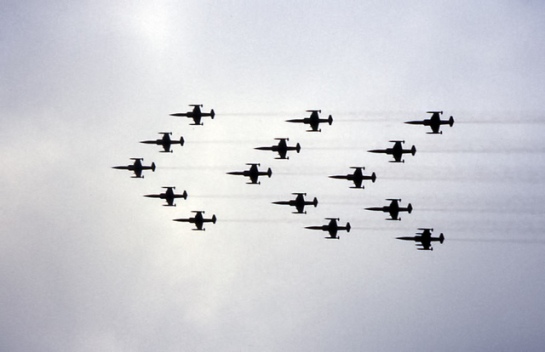The Limousine was one of the first attempts to produce an “enclosed passenger cabin aircraft”. Powered by a 60hp Austro-Daimler engine, t his paunchy aircraft had the Etrich’s famous Taube wing placed over a fuselage equipped with a gauze and celluliod covered cabin that housed 3 seats with the pilot behind.
Monthly Archives: November 2012
Yakovlev Yak-1000: A blessing in disguise.
The product of Yakovlev’s quest to built a supersonic tactical fighter to compete against Mikoyan Bureau. The 1000 was initially to be equipped with a Lyul’ka AL-5 axial jet engine, but problems with that power plant and the unavailability of others of the same power prompted Yakovlev to built the Yak-1000 just as a technology demonstrator. Powered by a modest Klimov RD-500 Derwent it was intended to prove the qualities of the “rhomboid” wing. All came to nothing because during taxi trials the combination of airframe, crosswind and bicycle undercarriage showed such a nasty behaviour that the project was cancelled without achieving a single flight.
Later tests also found that those wings, specially with that flap/aileron combination, posed serious in flight stability problems with technical solutions which were out of reach at that stage.
Croatian Bf 109G-14: Cool Balkenkreuz’s “Spin-Off”
Warner / Piper Twin Cub: Siamese, but not quite twins.
If marrying two aircraft to make a twin-engined aircraft is not enough, Harold Warner chose two different variants of the world famous Cub to spice things a bit more. The pair of Cubs were a classic 1937 J-3 modified with an enclosed cowling and a 85hp Continental engine to match the characteristics of the other, a refined 1947 PA-11. To place the two fuselage so close he used propeller-overlap design again as in his previous Twin-Pacer. This outrageously cool experiments were short-lived, a pity.
Apollo CM: Our only Starship.
Kawanishi N1K2-Ja Shiden Kai: Be Resourceful & Slim

Smithsonian National Air and Space Museum photographer Eric Long taking a shot of the cockpit panel of the Kawanishi N1K2-Ja Shiden Kai “George”.
Photo: Dane Penland
Flygvapnet’s J 11 (C.R. 42bis Falco): Cavefalcons
Sukhoi Su-7B: The very fit “Fitter”.
Sopwith F.1 Camel Home Defense: What is a Camel without a hump?
With the increase of raids by both aircraft and Zeppelins in the second half of 1917 came the need of a better performance fighter to use against them. The Camel was one of the obvious choices.The Home Defence variant, nicknamed “Comic Camels”, substituted the usual two Vickers MG of the standard Camel (and its hump fairing) by two overwing Lewis MG Those Lewis were better suited to be used with the more effective incendiary ammunition, and its over the wing position didn’t affect the night vision of the pilots.
A Camel only by name, but an effective one.









